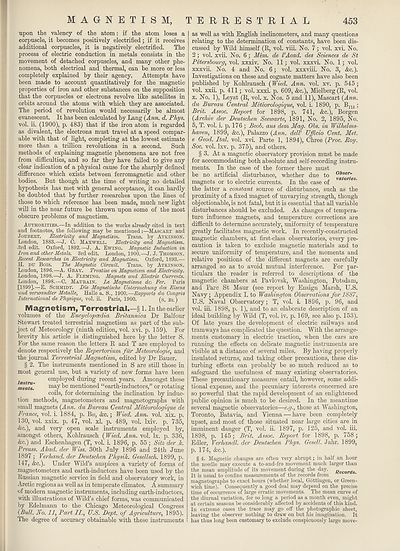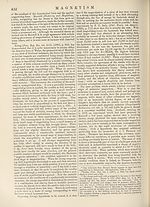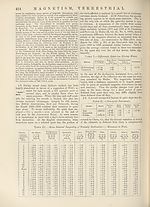New volumes of the Encyclopædia Britannica > Volume 30, K-MOR
(483) Page 453 - Magnetism, Terrestrial
Download files
Complete book:
Individual page:
Thumbnail gallery: Grid view | List view

MAGNETISM, TERRESTRIAL
453
upon the valency of the atom: if the atom loses a
corpuscle, it becomes positively electrified; if it receives
additional corpuscles, it is negatively electrified. The
process of electric conduction in metals consists in the
movement of detached corpuscles, and many other phe¬
nomena, both electrical and thermal, can be more or less
completely explained by their agency. Attempts have
been made to account quantitatively for the magnetic
properties of iron and other substances on the supposition
that the corpuscles or electrons revolve like satellites in
orbits around the atoms with which they are associated.
The period of revolution would necessarily be almost
evanescent. It has been calculated by Lang {Ann. d. Phys.
vol. ii. (1900), p. 483) that if the iron atom is regarded
as divalent, the electrons must travel at a speed compar¬
able with that of light, completing at the lowest estimate
more than a trillion revolutions in a second. Such
methods of explaining magnetic phenomena are not free
from difficulties, and so far they have failed to give any
•clear indication of a physical cause for the sharply defined
difference which exists between ferromagnetic and other
bodies. But though at the time of writing no detailed
hypothesis has met with general acceptance, it can hardly
be doubted that by further researches upon the lines of
those to which reference has been made, much new light
will in the near future be thrown upon some of the most
obscure problems of magnetism.
Authorities.—In addition to the works already cited in text
and footnotes, the following may be mentioned:—Mascart and
Joubert. Electricity and Magnetism. Trans, by Atkinson.
London, 1883.—-J. C. Maxwell. Electricity and Magnetism.
•3rd edit. Oxford, 1892.—J. A. Ewing. Magnetic Induction in
Iron and other Metals. 3rd edit. London, 1900.—J. J. Thomson.
Eecent Researches in Electricity and Magnetism. Oxford, 1893.—
H. nu Bois. The Magnetic Circuit. Trans, by Atkinson.
London, 1896.—A. Gray. Treatise on Magnetism and Electricity.
London, 1898.—J. A. Fleming. Magnets and Electric Currents.
London, 1898.—0. Maurain. Le Magnetisms di: Fer. Paris
[1899].—E. Schmidt. Die Magnetische Untersuchung des Eisens
und verwandter Metalle, Halle a. S., 1900.—Rapports du Congrbs
International de Physique, vol. ii. Paris, 1900. (s. Bi.)
Magnetism, Terrestrial.—§ 1. In the earlier
volumes of the Encyclopaedia Britannica Dr Balfour
Stewart treated terrestrial magnetism as part of the sub¬
ject of Meteorology (ninth edition, vol. xvi. p. 159). For
brevity his article is distinguished here by the letter S.
For the same reason the letters It and T are employed to
denote respectively the Repertorium fur Meteorologie, and
the journal Terrestrial Magnetism, edited by Dr Bauer.
§ 2. The instruments mentioned in S are still those in
most general use, but a variety of new forms have been
employed during recent years. Amongst these
may be mentioned “earth-inductors,” or rotating
coils, for determining the inclination by induc¬
tion methods, magnetometers and magnetographs with
small magnets {Ann. du Bureau Central Meteorologique de
France, vol. i. 1884, p. B57, &c.; Wied. Ann. vol. xix. p.
130, vol. xxix. p. 47, vol. xl. p. 489, vol. Ixiv. p. 735,
<fcc.), and very open scale instruments employed by,
amongst others, Kohlrausch (Wied. Ann. vol. lx. p. 336,
&c.) and Eschenhagen (T, vol. i. 1896, p. 55; Sitz der .k.
Breuss. Akad. der Wiss. 30th July 1896 and 24th June
1897 ; Verhand. der Deutschen Physik. Gesellsch. 1899, p.
147, &c.). Under Wild’s auspices a variety of forms of
magnetometers and earth-inductors have been used by the
Russian magnetic service in field and observatory work, in
Arctic regions as well as in temperate climates. A summary
of modern magnetic instruments, including earth-inductors,
with illustrations of Wild’s chief forms, was communicated
by Edelmann to the Chicago Meteorological Congress
{Bull. No. 11, Part II., U.S. Dept, of Agriculture, 1895).
The degree of accuracy obtainable with these instruments
Instru¬
ments.
as well as with English inclinometers, and many questions
relating to the determination of constants, have been dis¬
cussed by Wild himself (R, vol. viii. No. 7; vol. xvi. No.
2; vol. xvii. No. 6; Mem. de VAcad, des Sciences de St
Petersbourg, vol. xxxiv. No. 11; vol. xxxvi. No. 1; vol.
xxxvii. No. 4 and No. 6; vol. xxxviii. No. 3, &c.).
Investigations on these and cognate matters have also been
published by Kohlrausch (Wied. Ann. vol. xv. p. 545;
vol. xxii. p. 411; vol. xxxi. p. 609, &c.), Mielberg (R, vol.
x. No. 1), Leyst (R, vol. x. Nos. 5 and 11), Mascart {Ann.
du Bureau Central Meteorologique, vol. i. 1890, p. B118 :
Brit. Assoc. Report for 1898, p. 741, &c.), Bergen
{Archiv der Deutschen Seewarte, 1891, No. 2, 1895, No.
5, T. vol. i. p. 176; Beob. aus dem Mag. Obs. in Wilhelms-
haven, 1899, &c.), Palazzo {Ann. delV Ufficio Cent. Met.
e Geod. Ital. vol. xvi. Parte 1, 1894), Chree {Proc. Roy.
Soc. vol. Ixv. p. 375), and others.
§ 3. At a magnetic observatory provision must be made
for accommodating both absolute and self-recording instru¬
ments. In the case of the former there must
be no artificial disturbance, whether due to °bfr~
• 7 vatories.
magnets or to electric currents. In the case of
the latter a constant source of disturbance, such as the
proximity of a fixed magnet of unvarying strength, though
objectionable, is not fatal, but it is essential that all variable
disturbances should be excluded. As changes of tempera¬
ture influence magnets, and temperature corrections are
difficult to determine accurately, uniformity of temperature
greatly facilitates magnetic work. In recently-constructed
magnetic chambers, at first-class observatories, every pre¬
caution is taken to exclude magnetic materials and to
secure uniformity of temperature, and the moments and
relative positions of the different magnets are carefully
arranged so as to avoid mutual interference. For par¬
ticulars the reader is referred to descriptions of the
magnetic chambers at Pavlovsk, Washington, Potsdam,
and Parc St Maur (see report by Ensign Marsh, U.S.
Navy ; Appendix I. to Washington Observations for 1887,
U.S. Naval Observatory; T, vol. i. 1896, p. 96, and
vol. iii. 1898, p. 1), and to an elaborate description of an
ideal building by Wild (T, vol. iv. p. 169, see also p. 153).
Of late years the development of electric railways and
tramways has complicated the question. With the arrange¬
ments customary in electric traction, when the cars are
running the effects on delicate magnetic instruments are
visible at a distance of several miles. By having properly
insulated returns, and taking other precautions, these dis¬
turbing effects can probably be so much reduced as to
safeguard the usefulness of many existing observatories.
These precautionary measures entail, however, some addi¬
tional expense, and the pecuniary interests concerned are
so powerful that the rapid development of an enlightened
public opinion is much to be desired. In the meantime
several magnetic observatories—e.g., those at Washington,
Toronto, Batavia, and Vienna — have been completely
upset, and most of those situated near large cities are in
imminent danger (T, vol. ii. 1897, p. 125, and vol. iii.
1898, p. 145; Brit. Assoc. Report for 1898, p. 758;
Edler, Verhandl. der Deutschen Phys. Gesell. Jahr. 1899,
p. 174, &c.).
§ 4. Magnetic changes are often very abrupt; in half an hour
the needle may execute a to-and-fro movement much larger than
the mean amplitude of its movement during the day. pecords
It is usual to confine measurements of the records from
magnetographs to exact hours (whether local, Gottingen, or Green¬
wich time). Consequently a good deal may depend on the precise
time of occurrence of large erratic movements. The mean curve of
the diurnal variation, for so long a period as a month even, might
at certain seasons be considerably afiected by accidents of this kind.
In extreme cases the trace may go off the photographic sheet,
leaving the observer nothing to draw on but his imagination. It
has thus long been customary to exclude conspicuously large move-
453
upon the valency of the atom: if the atom loses a
corpuscle, it becomes positively electrified; if it receives
additional corpuscles, it is negatively electrified. The
process of electric conduction in metals consists in the
movement of detached corpuscles, and many other phe¬
nomena, both electrical and thermal, can be more or less
completely explained by their agency. Attempts have
been made to account quantitatively for the magnetic
properties of iron and other substances on the supposition
that the corpuscles or electrons revolve like satellites in
orbits around the atoms with which they are associated.
The period of revolution would necessarily be almost
evanescent. It has been calculated by Lang {Ann. d. Phys.
vol. ii. (1900), p. 483) that if the iron atom is regarded
as divalent, the electrons must travel at a speed compar¬
able with that of light, completing at the lowest estimate
more than a trillion revolutions in a second. Such
methods of explaining magnetic phenomena are not free
from difficulties, and so far they have failed to give any
•clear indication of a physical cause for the sharply defined
difference which exists between ferromagnetic and other
bodies. But though at the time of writing no detailed
hypothesis has met with general acceptance, it can hardly
be doubted that by further researches upon the lines of
those to which reference has been made, much new light
will in the near future be thrown upon some of the most
obscure problems of magnetism.
Authorities.—In addition to the works already cited in text
and footnotes, the following may be mentioned:—Mascart and
Joubert. Electricity and Magnetism. Trans, by Atkinson.
London, 1883.—-J. C. Maxwell. Electricity and Magnetism.
•3rd edit. Oxford, 1892.—J. A. Ewing. Magnetic Induction in
Iron and other Metals. 3rd edit. London, 1900.—J. J. Thomson.
Eecent Researches in Electricity and Magnetism. Oxford, 1893.—
H. nu Bois. The Magnetic Circuit. Trans, by Atkinson.
London, 1896.—A. Gray. Treatise on Magnetism and Electricity.
London, 1898.—J. A. Fleming. Magnets and Electric Currents.
London, 1898.—0. Maurain. Le Magnetisms di: Fer. Paris
[1899].—E. Schmidt. Die Magnetische Untersuchung des Eisens
und verwandter Metalle, Halle a. S., 1900.—Rapports du Congrbs
International de Physique, vol. ii. Paris, 1900. (s. Bi.)
Magnetism, Terrestrial.—§ 1. In the earlier
volumes of the Encyclopaedia Britannica Dr Balfour
Stewart treated terrestrial magnetism as part of the sub¬
ject of Meteorology (ninth edition, vol. xvi. p. 159). For
brevity his article is distinguished here by the letter S.
For the same reason the letters It and T are employed to
denote respectively the Repertorium fur Meteorologie, and
the journal Terrestrial Magnetism, edited by Dr Bauer.
§ 2. The instruments mentioned in S are still those in
most general use, but a variety of new forms have been
employed during recent years. Amongst these
may be mentioned “earth-inductors,” or rotating
coils, for determining the inclination by induc¬
tion methods, magnetometers and magnetographs with
small magnets {Ann. du Bureau Central Meteorologique de
France, vol. i. 1884, p. B57, &c.; Wied. Ann. vol. xix. p.
130, vol. xxix. p. 47, vol. xl. p. 489, vol. Ixiv. p. 735,
<fcc.), and very open scale instruments employed by,
amongst others, Kohlrausch (Wied. Ann. vol. lx. p. 336,
&c.) and Eschenhagen (T, vol. i. 1896, p. 55; Sitz der .k.
Breuss. Akad. der Wiss. 30th July 1896 and 24th June
1897 ; Verhand. der Deutschen Physik. Gesellsch. 1899, p.
147, &c.). Under Wild’s auspices a variety of forms of
magnetometers and earth-inductors have been used by the
Russian magnetic service in field and observatory work, in
Arctic regions as well as in temperate climates. A summary
of modern magnetic instruments, including earth-inductors,
with illustrations of Wild’s chief forms, was communicated
by Edelmann to the Chicago Meteorological Congress
{Bull. No. 11, Part II., U.S. Dept, of Agriculture, 1895).
The degree of accuracy obtainable with these instruments
Instru¬
ments.
as well as with English inclinometers, and many questions
relating to the determination of constants, have been dis¬
cussed by Wild himself (R, vol. viii. No. 7; vol. xvi. No.
2; vol. xvii. No. 6; Mem. de VAcad, des Sciences de St
Petersbourg, vol. xxxiv. No. 11; vol. xxxvi. No. 1; vol.
xxxvii. No. 4 and No. 6; vol. xxxviii. No. 3, &c.).
Investigations on these and cognate matters have also been
published by Kohlrausch (Wied. Ann. vol. xv. p. 545;
vol. xxii. p. 411; vol. xxxi. p. 609, &c.), Mielberg (R, vol.
x. No. 1), Leyst (R, vol. x. Nos. 5 and 11), Mascart {Ann.
du Bureau Central Meteorologique, vol. i. 1890, p. B118 :
Brit. Assoc. Report for 1898, p. 741, &c.), Bergen
{Archiv der Deutschen Seewarte, 1891, No. 2, 1895, No.
5, T. vol. i. p. 176; Beob. aus dem Mag. Obs. in Wilhelms-
haven, 1899, &c.), Palazzo {Ann. delV Ufficio Cent. Met.
e Geod. Ital. vol. xvi. Parte 1, 1894), Chree {Proc. Roy.
Soc. vol. Ixv. p. 375), and others.
§ 3. At a magnetic observatory provision must be made
for accommodating both absolute and self-recording instru¬
ments. In the case of the former there must
be no artificial disturbance, whether due to °bfr~
• 7 vatories.
magnets or to electric currents. In the case of
the latter a constant source of disturbance, such as the
proximity of a fixed magnet of unvarying strength, though
objectionable, is not fatal, but it is essential that all variable
disturbances should be excluded. As changes of tempera¬
ture influence magnets, and temperature corrections are
difficult to determine accurately, uniformity of temperature
greatly facilitates magnetic work. In recently-constructed
magnetic chambers, at first-class observatories, every pre¬
caution is taken to exclude magnetic materials and to
secure uniformity of temperature, and the moments and
relative positions of the different magnets are carefully
arranged so as to avoid mutual interference. For par¬
ticulars the reader is referred to descriptions of the
magnetic chambers at Pavlovsk, Washington, Potsdam,
and Parc St Maur (see report by Ensign Marsh, U.S.
Navy ; Appendix I. to Washington Observations for 1887,
U.S. Naval Observatory; T, vol. i. 1896, p. 96, and
vol. iii. 1898, p. 1), and to an elaborate description of an
ideal building by Wild (T, vol. iv. p. 169, see also p. 153).
Of late years the development of electric railways and
tramways has complicated the question. With the arrange¬
ments customary in electric traction, when the cars are
running the effects on delicate magnetic instruments are
visible at a distance of several miles. By having properly
insulated returns, and taking other precautions, these dis¬
turbing effects can probably be so much reduced as to
safeguard the usefulness of many existing observatories.
These precautionary measures entail, however, some addi¬
tional expense, and the pecuniary interests concerned are
so powerful that the rapid development of an enlightened
public opinion is much to be desired. In the meantime
several magnetic observatories—e.g., those at Washington,
Toronto, Batavia, and Vienna — have been completely
upset, and most of those situated near large cities are in
imminent danger (T, vol. ii. 1897, p. 125, and vol. iii.
1898, p. 145; Brit. Assoc. Report for 1898, p. 758;
Edler, Verhandl. der Deutschen Phys. Gesell. Jahr. 1899,
p. 174, &c.).
§ 4. Magnetic changes are often very abrupt; in half an hour
the needle may execute a to-and-fro movement much larger than
the mean amplitude of its movement during the day. pecords
It is usual to confine measurements of the records from
magnetographs to exact hours (whether local, Gottingen, or Green¬
wich time). Consequently a good deal may depend on the precise
time of occurrence of large erratic movements. The mean curve of
the diurnal variation, for so long a period as a month even, might
at certain seasons be considerably afiected by accidents of this kind.
In extreme cases the trace may go off the photographic sheet,
leaving the observer nothing to draw on but his imagination. It
has thus long been customary to exclude conspicuously large move-
Set display mode to:
![]() Universal Viewer |
Universal Viewer | ![]() Mirador |
Large image | Transcription
Mirador |
Large image | Transcription
Images and transcriptions on this page, including medium image downloads, may be used under the Creative Commons Attribution 4.0 International Licence unless otherwise stated. ![]()
| Encyclopaedia Britannica > New volumes of the Encyclopædia Britannica > Volume 30, K-MOR > (483) Page 453 - Magnetism, Terrestrial |
|---|
| Permanent URL | https://digital.nls.uk/193573780 |
|---|
| Attribution and copyright: |
|
|---|---|
| Shelfmark | EB.18 |
|---|---|
| Description | Ten editions of 'Encyclopaedia Britannica', issued from 1768-1903, in 231 volumes. Originally issued in 100 weekly parts (3 volumes) between 1768 and 1771 by publishers: Colin Macfarquhar and Andrew Bell (Edinburgh); editor: William Smellie: engraver: Andrew Bell. Expanded editions in the 19th century featured more volumes and contributions from leading experts in their fields. Managed and published in Edinburgh up to the 9th edition (25 volumes, from 1875-1889); the 10th edition (1902-1903) re-issued the 9th edition, with 11 supplementary volumes. |
|---|---|
| Additional NLS resources: |
|

